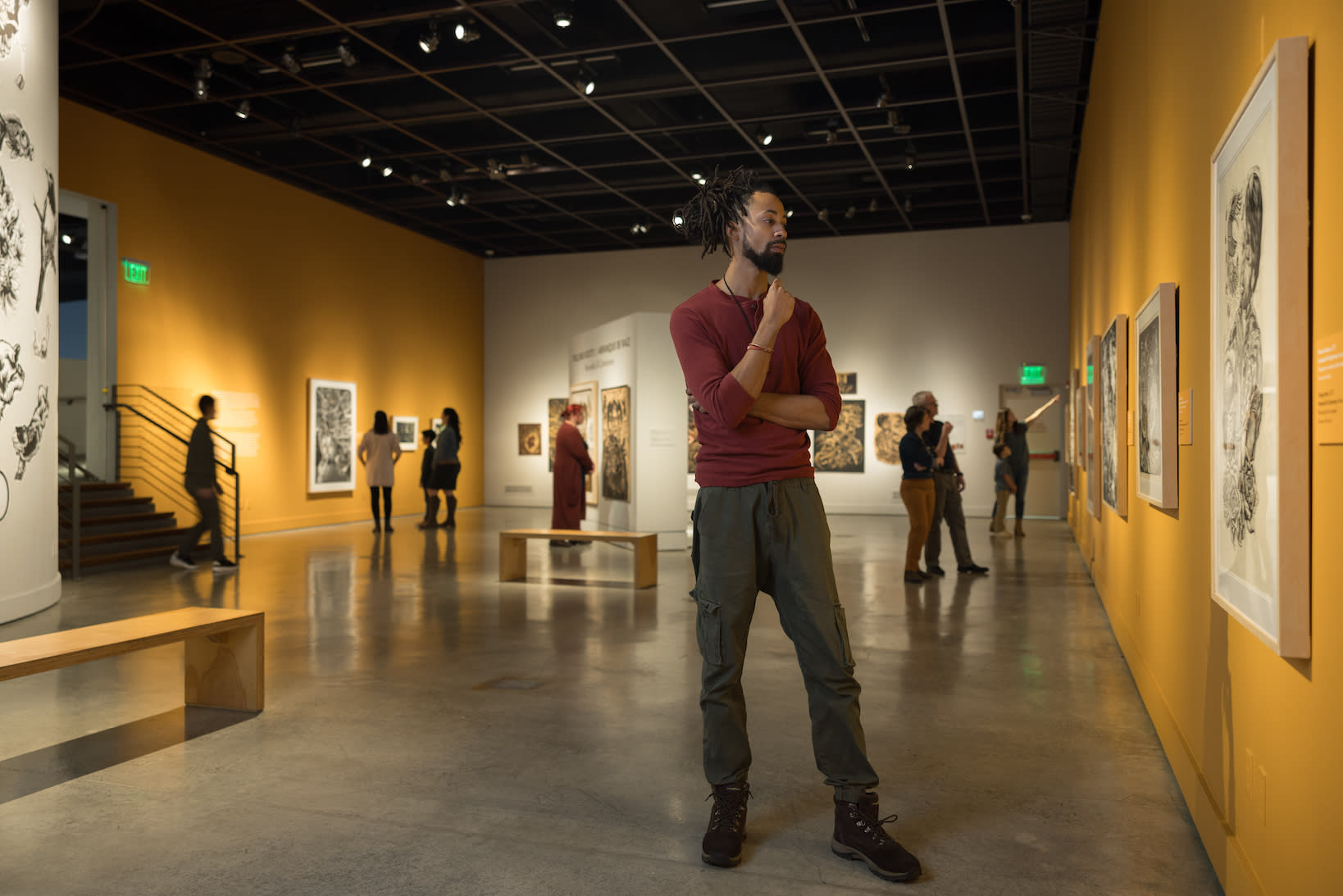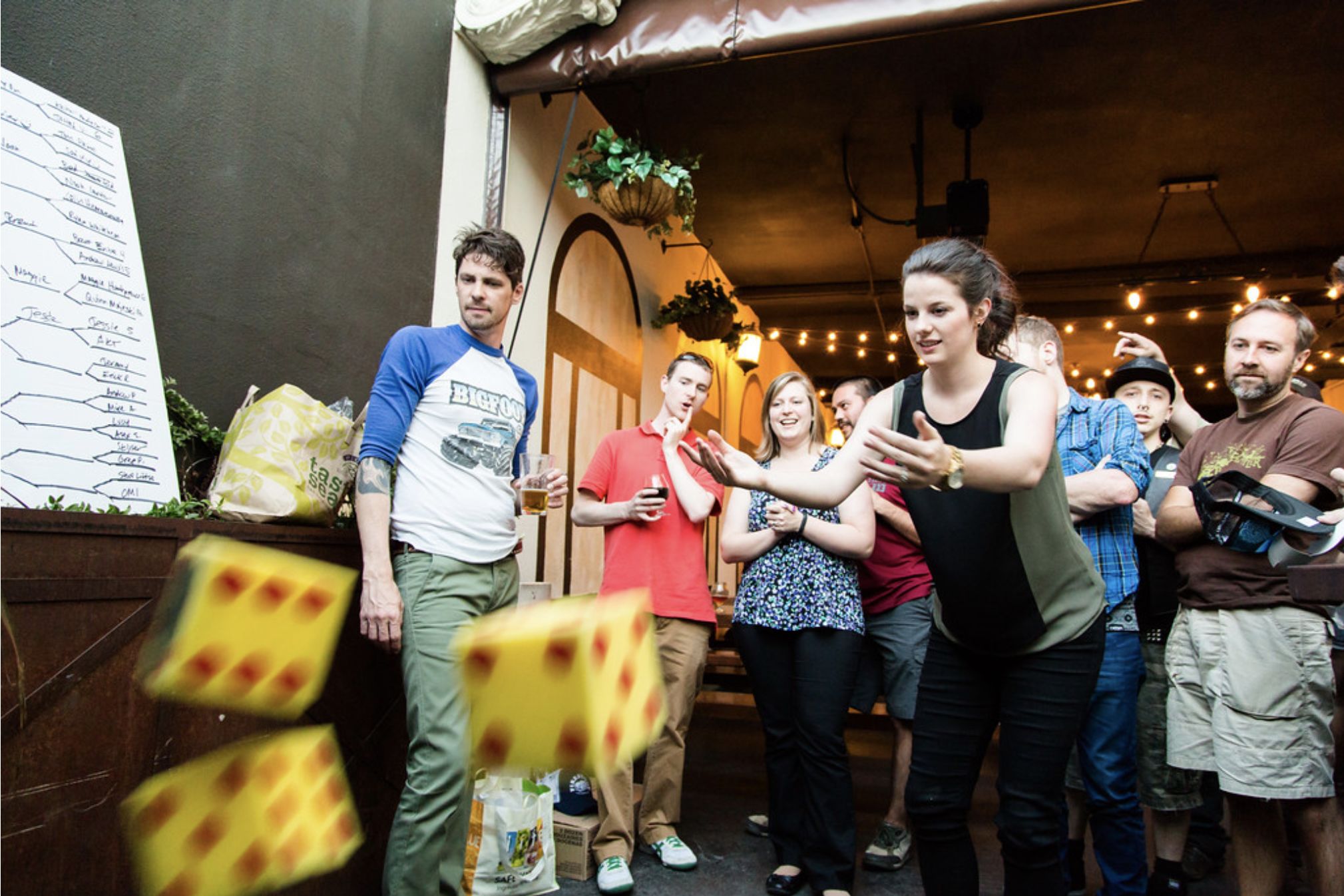The Artist Who Volleys Ceramics, Papier-Mâché, Needlepoint, and Tennis?

Jessica Jackson Hutchins at the opening of her show Ruined Windows at Adams and Ollman in Portland.
Image: Michael Raines
Jessica Jackson Hutchins, 53, says her work comes “in nuggets.” These “nuggets”—fits of inspiration—are equally likely to manifest as battered old chairs and couches engulfed by humanoid ceramic sculptures as abstract paintings on paper and canvases knotted in needlepoint. They come as wearable ceramic feeding vessels, papier-mâché “prostheses,” and planes of fused glass standing two-stories high. New York Magazine art critic Jerry Saltz praised Hutchins’s “microcosmic colosseums” in 2015, and counted her “among the best artists working in America today.” Institutional support has been equally enthusiastic: Hutchins was a 2022 Guggenheim fellow and has work in the collections of the Whitney and MoMA.
Most of the above can be seen in her current survey show (through May 5), Wrecked and Righteous, at the Frye Art Museum. What’s rolling around the frenzied mind of such a hyperactive artist? Mostly tennis, turns out, and touchstones as far flung as you’d hope.
Describe your studio.
It’s fun. Is that corny? I don’t know: It’s fun; it’s like a whirlwind. I move in circles around materials and processes and things I made in the past. I touch whatever thing I desire at the moment. So things move in this really expansive, fun way.
What’s the most impractical thing you keep there?
Floor to ceiling storage of old furniture. The craziest thing is an old steel picnic table from some city park in Minneapolis that the artist Jay Heikes mailed to me years ago. It’s giant—benches and everything. I actually take prints off of it. I’ve printed on my ceramics with it. The blue painting that Portland Art Museum owns [Might (2015)] has some of the prints from that table.
Give me the bullet points of a typical day.
After dropping the kid [her teenage daughter, Sunday, youngest of two], pacing around the studio—say I decide I’m gonna work in papier maché—I’ll make coffee and gather my materials. But between making coffee and walking back to that piece, it is very likely that something else will catch my eye. I might start working in clay instead. I don’t put any boundaries on that. I really follow that energy.
And that’s every day?
Every day that I love.
Where are you a regular?
At the Portland Tennis Center [laughs]. It’s my favorite place on earth. I started playing every day in Covid—outside, in the rain, and in the snow if we had to—then you can’t run. It’s unreasonable how much I play tennis, and how much I think about tennis. I was just watching the frickin Australian Open from three in the afternoon until four in the morning.
Tell me about your social life.
My friends and I, we understand each other because we have creative struggles, even if that’s not always a topic of conversation. I have a marriage with an artist [Pavement frontman Stephen Malkmus]. It’s not like we don’t sit around and talk about our art. But at the same time, we can allow each other that kind of space and weirdness and unavailability.
Three words to describe being an artist in America?
You need resilience, and you need to be defiant; you need to be working against a kind of commodification—so rebellious. They all mean the same thing, don’t they?
What about in Portland?
A little off the grid here. But there’s a sweetness to it.
Do you ever walk away from a piece and then come back to it?
Oh, so much. I believe that my work does its own work when I’m not there. It’s got its own agenda. So I’ll do two things to a piece, and then I’ll let it work with time on its own. I like a lot of time to pass. Sometimes years.
How long have you been thinking about the Frye show?
Things work in the back of my head. Seattle is a full survey show. I didn’t even realize what a big deal it was until it had been on the calendar for over a year. And then the curator and I started talking about including what we’re calling “the juvenilia,” pieces I made in the late ’90s [pause]. It’s very tender. It’s, like, my whole life.

Image: Michael Raines
What inspires your work beyond visual art?
I mean, I look at poetry more than art. Literature and music have influenced it probably more than looking at art. I never thought I would care about Robert Frost. But the first line of his poem “Directive” is so achingly beautiful that I can’t deal. And that’s what I want my work to feel like.
What was the last great show you saw?
sidony o’neal’s last show at PICA, ENCHIRIDION: aisle, spline, resort. They’re a really smart, present sculptor. You could feel all the deliberation and intelligence behind the show, but you didn’t have to know any specifics to get it.
I couldn’t get this ladder piece out of my head. I use ladders in my work [laughs] and I’d never seen anyone else do it. And then they made these little, tiny objects, kinda maybe based on Ghanaian gold weights—which I grew up with; my mother was an African art historian. The extreme relationship of scale between the two was really exciting.
A show you’re looking forward to?
Rainen Knecht is a really amazing painter. Her work has been growing in leaps and bounds. I don’t know if she has another show coming up in this town [Knecht is Portland-based] but I’m really looking forward to seeing her next body of work.
One Portland-centered piece of art that everyone should know?
Lawrence Halprin and Associates’ brutalist landscape architecture: the Keller Fountain, the Lovejoy Fountain—that’s been pretty neglected—and Pettygrove Park. The Lovejoy Fountain is really cool for skateboarding. And those hills at Pettygrove Park!
If you could have coffee with one dead Portland artist?
Maybe Leroy Setziol and Ursula K. Le Guin. I really like Setziol; he was a wood-carver. And who wouldn’t want to have coffee with Ursula? She was such a brilliant thinker. Actually, the three of us, that might be beautiful, because I’m guessing he was a man of few words. I don’t know if that’s true.
This interview has been edited and condensed for clarity. It originally appeared in Portland Monthly.




